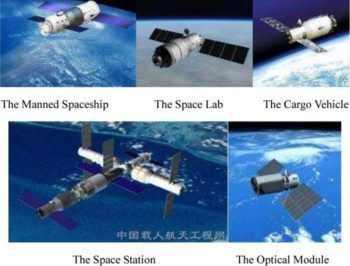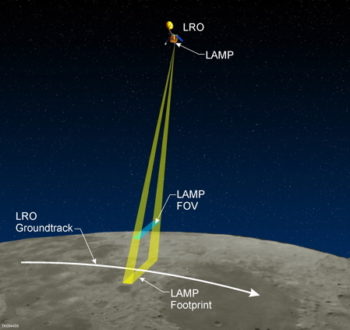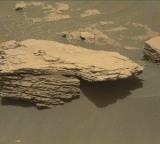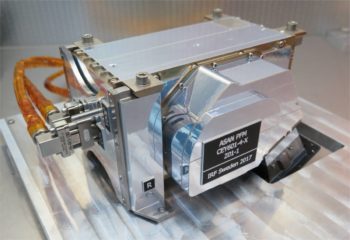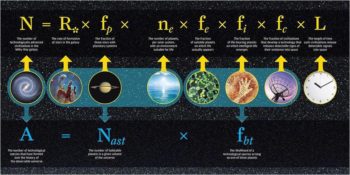Archive for March, 2019
The International Space Station partners have endorsed plans to continue the development of the Gateway, an outpost around the Moon that will act as a base to support both robots and astronauts exploring the lunar surface.
The Multilateral Coordination Board, which oversees the management of the Space Station, stressed its common hope for the Gateway to open up a cost-effective and sustainable path to the Moon and beyond.
A possible commitment towards building Europe’s contributions to the Gateway will be one of the key decisions to be made by Ministers at the Space19+ Conference in November 2019.
The European Space Agency’s (ESA) potential involvement includes the ESPRIT module to provide communications and refueling of the Gateway and a science airlock for deploying science payloads and cubesats.

During the 2020s, the Gateway will be assembled and operated in the vicinity of the Moon, where it will move between different orbits and enable the most distant human space missions ever attempted.
Credit: NASA/ESA
The endorsement comes after several years of extensive study among space agencies who have developed a technically achievable design. The partnership includes European countries (represented by ESA), the United States (NASA), Russia (Roscosmos), Canada (CSA) and Japan (JAXA).
The Cosma Hypothesis: Implications of the Overview Effect by Frank White; Morgan Brook Media (March 2019; paperback: 269 pages, $19.95.
It takes a special kind of person to come up with a special kind of effect.
Frank White coined the term: “The Overview Effect” – the experience of seeing the Earth from orbit or the Moon – on humanity’s perceptions of our home world and our place in the cosmos.
White’s book, The Overview Effect: Space Exploration and Human Evolution, was first published by Houghton-Mifflin in 1987. This trailblazing work is now in its third edition, and is a seminal work in the field of space exploration and development. His just released new book is The Cosma Hypothesis: Implications of the Overview Effect.
In short, this impressive volume puts forward that our purpose in exploring space should transcend focusing on how it will benefit humanity. We should ask how to create a symbiotic relationship with the universe, giving back as much as we take, and spreading life, intelligence, and self-awareness throughout the solar system and beyond.
Given the wistful and wishful space futurism of the day – space tourism, mining space rocks, living on the Moon and occupying cities on Mars — White argues that developing a philosophy of space exploration and settlement is more than an intellectual exercise: it will powerfully influence policy and practices that are now unfolding.
The reader will enjoy pondering a number of themes in the book, from the appropriate approach to mining asteroids and the moon, the possible need to revise the UN 1967 Outer Space Treaty, to the role Artificial Intelligence (AI) will play in helping humans explore and develop the cosmos.
Of special interest are 16 content-specific task forces that are a healthy part of the New Human Space Program chapter – key issues arising out of human expansion into our “solar neighborhood.”
This heartfelt book is thought-provoking. Why has the evolutionary process brought humanity to the brink of becoming a spacefaring species?” The author concludes that our purpose, or ecological function, is to support the universe (Cosma) in reaching a higher level of life, intelligence, and self-awareness.
White adds: “As Cosma become more conscious, the universe will become a more welcoming place for Homo sapiens, and we will evolve together.”
In an author’s note, White requests that a reader can learn more about The Human Space Program, contact him at: Cosmatheory1@gmail.com
For more information on this book, go to:
https://www.amazon.com/Cosma-Hypothesis-Implications-Overview-Effect/dp/173288613X

Prototype of the Tianhe core module. China’s space station is expected to be operational around 2022. CCTV/Screengrab
China will ramp up their human spaceflight program, tied to the establishment of the country’s space station.
Zhang Bonan, chief designer of the space program of China Aerospace Science and Technology Corporation, has stated that China intends to realize bulk production of crew-carrying spacecraft in the future instead of today’s customization.
As reported by China’s Science and Technology Daily report over the weekend, Zhang said to meet the space station’s demands around 2022, the country has to prepare enough spacecraft in advance.
Dramatic increase
The number of personnel and the volume of goods that transport between the ground and the space station will increase dramatically, Zhang said.
They will be launched based on the needs of the replacement of astronauts and the freight, “just like air flights,” Zhang said.
“Today’s China aerospace manufacturing industry has gained the ability to do small volume production through improved digitization and automation technology,” Zhang said.

Docking of China’s Shenzhou 10 spacecraft with the Tiangong-1 space station June 13, 2013.
Credit: CCTV
Spacecraft in quantity
Following the Shenzhou-10 spacecraft mission in June 2013, Zhang said, the country now has the ability to produce crew-carrying spacecraft in quantity.
In 1992, China launched its manned space flight program. The success of Shenzhou-5 in 2003 made China the third country to acquire human space travel technology on its own.
China’s most recent, and the sixth piloted space mission, Shenzhou-11, lifted off in mid-October 2016. The two-person crew made the first piloted docking with the Tiangong-2 space laboratory.
The Aerospace Industries Association (AIA) has issued its vision for the future — one that includes morning commutes via flying air taxi, supersonic business travel between continents, and an emerging market for space-based research and manufacturing in 2050
This new study – What’s Next for Aerospace and Defense: A Vision for 2050 — The result is a comprehensive look at innovations that will shape the world over the next thirty years.
The study was launched today with an interactive experience at South by Southwest (SXSW) now underway in Austin, Texas.
AIA represents more than 300 aerospace and defense manufacturers and suppliers, with the study built on interviews with over 70 industry leaders.
The variety of activities characterized in the study includes space mining.
Given the mineral riches floating in the cosmos, the study points out, commercial space manufacturing and mining “may move from the realm of science fiction into reality.”
“The underlying technology to enable such a space use case could even become widespread once the economics become viable,” the report explains.
Nascent stages
The study explains that, as interest in the commercial potential of space grows, exploration will likely become the focus of increasing public attention again.
In-depth research and exploration in space will be in its initial stages, but commercial research activity in support of that interest will likely increase:
- Nascent: Space infrastructure—including off -Earth bases, supply hubs, and orbital fuel stations—will support expanded activities in space and make space travel safer and more sustainable.
- Nascent: Space-based research, resource extraction, and manufacturing will take advantage of space’s unique conditions, such as extreme heat, zero gravity, and consistent solar energy.
Launch cost reduction
Furthermore, an increasingly dense constellation of low Earth orbiting (LEO) satellites is setting the stage for low-cost research across a variety of fields.
“Reductions in launch cost and improved sensor sensitivity across the electromagnetic spectrum will combine to make exploration and commercial activity in space more economical,” the study suggests.
To get a glimpse into this technology-driven future, read the full-study at:
https://www.aia-aerospace.org/vision-2050
Watch a brief video inspired by Vision 2050 at:

InSight’s Instrument Deployment Camera (IDC) acquired this image of the HP3 experiment on Sol 99, March 8, 2019.
Credit: NASA/JPL-Caltech
Mixed news from the “mole” probe onboard NASA’s Mars InSight – part of Germany’s HP3 (Heat and Physical Properties Package) instrument.
It began hammering into the surface of Mars on February 28. However, the device may have come up against a rock or something else that is proving highly resistant beneath the surface. The researchers are now analyzing the data before it can continue hammering.

InSight’s Instrument Deployment Camera (IDC) acquired this image showing the HP3 experiment and SEIS seismometer (Seismic Experiment for Interior Structures) on Sol 99, March 8, 2019.
Credit: NASA/JPL-Caltech
The mole had come about three-quarters of the way out of its housing structure before stopping. Data also suggests that the device is at a 15-degree tilt.
Pause the hammering
“The team has therefore decided to pause the hammering for about two weeks to allow the situation to be analyzed more closely and jointly come up with strategies for overcoming the obstacle,” explains Tilman Spohn of the German Aerospace Center (Deutsches Zentrum für Luft- und Raumfahrt; DLR) Institute of Planetary Research and principal investigator of the HP3 experiment.
The HP3 team has commanded a large number of images to be taken by the cameras on the InSight lander and its robotic arm.
Play it safe
“Some of the images we already have, indicate that part of the mole is actually visible,” Spohn reports. “The consensus is that the mole is about 30 centimeters in the regolith and probably still 7 centimeters in the tube of the support structure. It is approximately pointing 15° away from the vertical and has undergone either some rotation or precession of its rotation axis.”
The instrument remains healthy. But the team wants to play it safe and get all the evidence that could become available including seismic data together to assist the mole overcome the obstacle (or to get through a possible layer of gravel). “Once we have all the data, we will decide on how to proceed best,” Spohn explains.

Components of the HP3 heat flow probe. Top left: the radiometer (RAD), which is used to measure the radiation temperature (roughly equivalent to the ground temperature) of the surface. Right: the casing with the mole penetrometer, the temperature measuring cable (TEM-P) and the data cable (ET) connected to the lander. In addition, the casing contains an optical length meter for determining the length of the temperature measuring cable that has been pulled from the casing. The mole contains the TEM-A active thermal conductivity sensor and the STATIL tiltmeter. Bottom left: the electronic control unit, known as the back end electronics (BEE), which remains on the lander and is connected to the probe via the ET.
Credit: DLR
Design heritage
The mole penetrometer was developed at the DLR Institute of Space Systems. It draws upon earlier developments at DLR and in Russia. An earlier version of the probe was built at the former DLR Institute of Space Simulation in Cologne as a sample collector for the Beagle II lander – flown as part of the Mars Express mission – which crashed onto the Martian surface in 2003. The hammering mechanism for the HP3 mole was developed by Astronika in Warsaw, Poland.
Phobos eclipse
Meanwhile, Spohn says there’s excellent news concerning the Mars moon, Phobos.
“We just got the data from the first Phobos eclipse observation and the cooling by the shadow passing through the fields of view of the radiometer in about 30 seconds is clearly visible,” Spohn notes. “So the team is happy and is rejoicing about the first eclipse on Mars ever observed with a radiometer.”

Set of three images shows views three seconds apart as the larger of Mars’ two moons, Phobos, passed directly in front of the sun as seen by NASA’s Mars rover Curiosity on Aug. 20, 2013.
Credit: NASA/JPL-Caltech/Malin Space Science Systems/Texas A&M Univ.
The Radiometer (RAD) is mounted underneath the platform of the lander and monitors the area beside the lander where HP3 is installed.
The team will analyze the RAD data and come up with a model of the uppermost millimeters or so of the Mars surface material. This measurement is called the thermal inertia. This quantity depends on the thermal conductivity of the near surface material, its density and its heat capacity.
“So, it is part of our efforts to measure the geophysical parameters of Mars,” Spohn says.

Data from the SwRI-led LAMP instrument aboard NASA’s Lunar Reconnaissance Orbiter indicate that water molecules scattered on the surface of the Moon are more common at higher latitudes and tend to hop around as the surface heats up. Characterizing the water on the Moon is critical to planning future exploration.
Courtesy of NASA/JPL/USGS
An instrument onboard NASA’s Lunar Reconnaissance Orbiter (LRO) indicates that water molecules scattered on the surface of the Moon are more common at higher latitudes and tend to hop around as the surface heats up.
“These results aid in understanding the lunar water cycle and will ultimately help us learn about accessibility of water that can be used by humans in future missions to the Moon,” said Amanda Hendrix, a senior scientist at the Planetary Science Institute.
Hot topic
The findings have been reported in the Hendrix-led paper – “Diurnally‐Migrating Lunar Water: Evidence from Ultraviolet Data” — published in the American Geophysical Union’s Geophysical Research Letters.
“This is an important new result about lunar water, a hot topic as our nation’s space program returns to a focus on lunar exploration,” said SwRI’s Kurt Retherford, the principal investigator of the LRO LAMP instrument.
“We recently converted the LAMP’s light collection mode to measure reflected signals on the lunar dayside with more precision,” Retherford said, “allowing us to track more accurately where the water is and how much is present.”
Surface water
According to a SwRI press statement, up until the last decade or so, scientists thought the Moon was arid, with any water existing mainly as pockets of ice in permanently shaded craters near the poles.
However, more recently, scientists have identified surface water in sparse populations of molecules bound to the lunar soil, or regolith. The amount and locations vary based on the time of day. This water is more common at higher latitudes and tends to hop around as the surface heats up.

A source of water on the Moon could help make future crewed missions more sustainable and affordable.
Credit: RegoLight, visualization: Liquifer Systems Group, 2018
As rough, irregularly shaped grains heat up over the course of a day, the molecules detach from the regolith and hop across the surface until they find another location cold enough to stick.
“A source of water on the Moon could help make future crewed missions more sustainable and affordable,” Hendrix explains. “Lunar water can potentially be used by humans to make fuel or to use for radiation shielding or thermal management; if these materials do not need to be launched from Earth, that makes these future missions more affordable”
To review the paper — “Diurnally‐Migrating Lunar Water: Evidence from Ultraviolet Data” – go to:
https://agupubs.onlinelibrary.wiley.com/doi/abs/10.1029/2018GL081821
NASA’s Curiosity Mars rover is now performing Sol 2341 science work.
The rover is finishing up at the “Midland Valley” outcrop, work that also included inspection of a wide range of new images.
“In those images the team discovered a block that allows a unique 3D view of the rocks in the area,” reports Susanne Schwenzer, a planetary geologist at The Open University, Milton Keynes in the U.K.

This target has now been named “Muir of Ord.” Curiosity Rear Hazcam Right A photo taken on Sol 2339, March 6, 2019.
Credit: NASA/JPL-Caltech
Rock of interest
As the rover stood at the moment, the rock of interest was just behind it, with the line of sight and Chemistry and Camera (ChemCam) line of laser shot blocked by the rover itself.
“The question was, whether to proceed as planned and drive away from the site, or to turn the rover around and take the opportunity to observe this block from the top and the side,” Schwenzer adds. “This way, we would gain a three-dimensional view of the layering as well as chemical information. This would be important information to investigate depositional conditions of those rocks, and thus help our understanding of the new environment of the clay-bearing unit, as part of which this rock was deposited. We decided to take the turn.
Unusual maneuver
As a start, in a recent plan, the rock was named “Muir of Ord” and – in an unusual maneuver only possible because of the very short and well understood drive to turn the rover around, Schwenzer explains.
Curiosity’s Mastcam will be able to get multispectral imagery in the same sol. Chemical information and the robot’s Mars Hand Lens Imager (MAHLI) will add to the investigations in the future.
Concludes Schwenzer: “So, stay tuned!”
A new study looks into the possibility of searching for black hole starships using very high energy gamma ray telescopes.
Louis Crane, a mathematician at Kansas State University, has authored – “Searching for Extraterrestrial Civilizations Using gamma Ray Telescopes” – and underscores the speculative thought that the object Oumuamua was in fact a probe sent to our solar system by an extraterrestrial civilization.

Artist’s concept of interstellar object1I/2017 U1 (‘Oumuamua) as it passed through the solar system after its discovery in October 2017. The aspect ratio of up to 10:1 is unlike that of any object seen in our own solar system. Image Credit: European Southern Observatory / M. Kornmesser
“The extremely improbable trajectory of this body, with its non-gravitational acceleration makes this suggestion plausible,” Crane observes.
Additionally recent work by the Kepler telescope seems to advocate that as many as one star in five in our galaxy has an earthlike planet circling it.
Special pattern of activity
“These facts make it seem more likely that our region in the Milky Way galaxy is inhabited by advanced alien civilizations some of whom are actively exploring interstellar space,” Crane senses.
A starship powered by a black hole or other very high energy source, would exhibit a very special pattern of activity. “Detecting this distinctive pattern should be feasible,” Crane explains.
Crane also feels that there have been “interesting potential candidates” already observed for black hole starships (BHSs), and tests to see if any of them are actual BHSs are not difficult to propose.
“If it is really true that black hole starships, or some similar high energy density drive ships exist,” Crane says, “they would play a more important role in the galaxy than would be apparent, because only a small number of their focused beams would reach us on Earth.”
The proposal of Crane’s paper is to examine the unidentified point-like very high energy gamma ray sources in the galaxy as possible starships.
Fermi paradox
As far as the existence of intelligent life elsewhere in the galaxy is concerned, Crane contends that there is really no reason to rule it out. Thus, there may be an answer to physicist Enrico Fermi’s question – Where is everybody? – the apparent contradiction between the lack of evidence and high probability estimates for the existence of extraterrestrial civilizations.
It might simply have been that they were rather hard to see, Crane adds, paradoxically because their emissions were too energetic.
The study is available online at:
International experiments carried onboard China’s Chang’e-4 farside mission are gathering good data, report their principal investigators.

Germany’s scientific payload is a Lunar Lander Neutron and Dosimetry instrument, developed by Kiel University. Credit: Kiel project manager, Jia Yu
The Lunar Lander Neutrons & Dosimetry experiment (LND) is part of the Chang’e-4 lander payload.
The LND instrument has two major science objectives: 1) dosimetry for human exploration of the Moon and 2) contribute to heliospheric science as an additional measuring point
“LND is working fine,” reports Robert Wimmer-Schweingruber of the Institut fuer Experimentelle und Angewandte Physik, University of Kiel in Germany. “We were turned on for the third lunar day last Friday and have now received our data or the previous two lunar days,” he told Inside Outer Space. “We see some variations in the dose rate with time which we need to understand before we start publishing the data.”
The LND device is designed to gauge radiation on the Moon, mainly for future human missions. It will also measure the water content underneath the lander.
Working flawlessly
Meanwhile, Sweden’s Advanced Small Analyzer for Neutrals (ASAN) carried by the Yutu-2 rover is also gathering data.
“Yes, we are doing fine! ASAN is operated typically twice per lunar day,” reports Martin Wieser of the Swedish Institute of Space Physics in Kiruna, Sweden.
“ASAN works flawlessly and the data is good. People are working on the first papers,” Wieser told Inside Outer Space.
Energetic sensor
ASAN was built in collaboration with the Chinese National Space Science Center (NSSC). It is the first time an energetic neutral atom sensor is deployed on the lunar surface. From a vantage point of only a few decimeters above the regolith surface, ASAN is geared to measure energy spectra of energetic neutral atoms originating from reflected solar wind ions under different solar wind illumination conditions.
ASAN is mounted on the Yutu-2 rover making it possible to perform measurements at different locations. The measurements could shed light on the processes responsible for the formation of water on the Moon.
Chang’e-4 landed within the South Pole-Aitken (SPA) Basin, the largest and deepest basin in the solar system. The January 3 touchdown was in Von Kármán crater, a 110 miles (186-kilometers) wide region.
An audit of the SETI Institute has been performed by the NASA Office of Inspector General.
Over the past 25 years, NASA has, according to Agency officials, provided only three grants totaling $1.6 million for research associated with the direct search for extraterrestrial intelligent life through the use of electromagnetic signals, the OIG report explains.
“It is not clear whether this limited funding is simply because technosignatures research has not been an Agency priority or whether it is due to confusion related to a 1-year congressional prohibition on such research in 1993. The broader scientific community has expressed interest in the search for extraterrestrial intelligent life in the past, as did a House of Representatives NASA authorization bill voted out of Committee in April 2018.”
Technosignatures 101
As noted in the report, technosignatures research is a collective term for scientific searches for intelligent extraterrestrial life and includes—but is not limited to—monitoring electromagnetic radiation for signs of transmissions from civilizations on other planets.
The SETI Institute is only one organization within a broader community of practitioners that conduct technosignatures research. Moreover, the Institute conducts wide-ranging scientific research in multiple disciplines that goes well beyond the search for intelligent life outside of Earth.

Source: NASA OIG presentation of information from “Searching for Good Science: The Cancellation of NASA’s SETI Program,” written by Stephen J. Garber of the NASA History Office and published in the Journal of The British Interplanetary Society, Vol. 52 (1999).
Strong partnership
The upshot from the audit: “The research conducted by the SETI Institute through its 85 awards with NASA has played an important role in advancing understanding of stars, planets, planetary satellites, and astrobiology, all of which reflect the Agency’s science goals and objectives.”
The reports further states: “We found that NASA followed its policies and federal guidelines when it solicited and selected the SETI Institute for these awards, and in turn, the Institute properly accounted for expenditures and complied with federal requirements. As a result, NASA and the Institute have forged a strong partnership and produced valuable data and research benefitting the scientific community.”
To review this interesting and informative document, go to:



